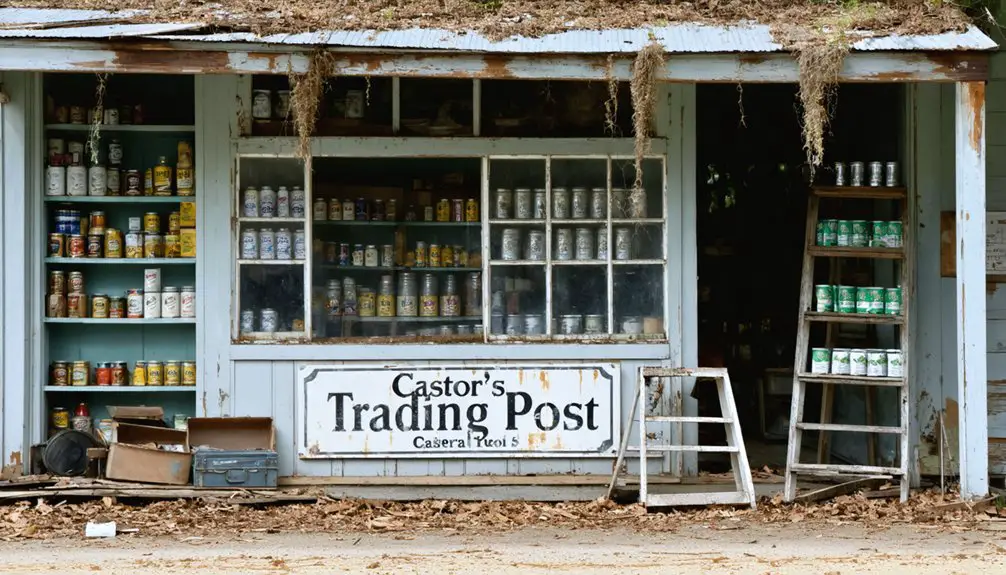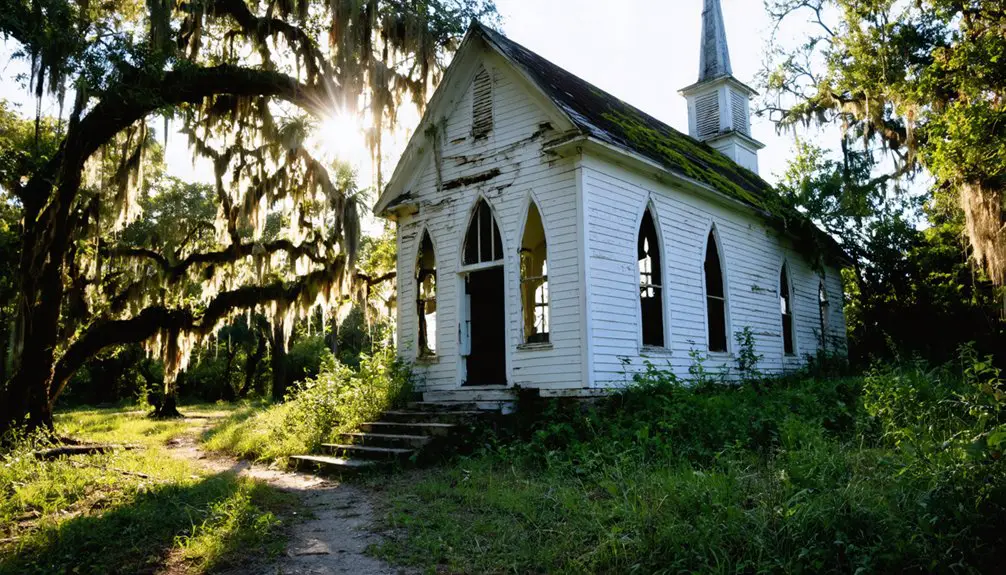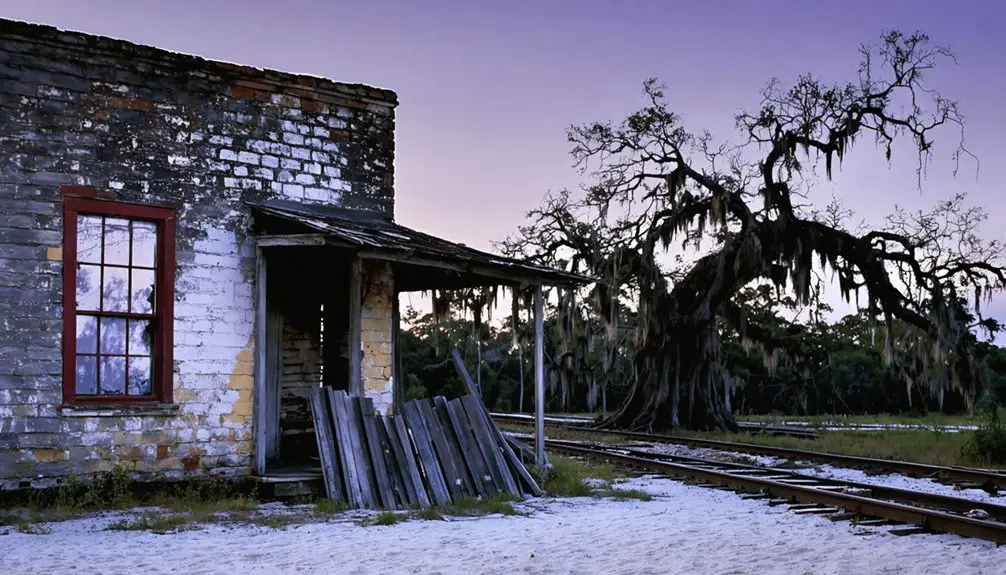You’ll find Castor Town’s haunting remains on Florida’s Egmont Key, where this once-bustling coastal settlement thrived in the post-Civil War era. Founded in the early 1800s, the town grew around timber harvesting and military operations until the devastating 1898 sawmill fire sparked its decline. Natural disasters, economic hardship, and military withdrawal sealed its fate. Today, only scattered foundations peek through native vegetation, while archaeological discoveries continue to reveal the settlement’s buried secrets.
Key Takeaways
- Castor Town was established in the early 1800s on Egmont Key, Florida, thriving initially through coastal agriculture, fishing, and sawmill operations.
- The catastrophic sawmill fire of 1898 destroyed the town’s primary economic engine, triggering widespread business closures and population exodus.
- Military withdrawal severely impacted the town’s economy and security, leading to further abandonment and vulnerability to Seminole raids.
- Natural disasters, particularly hurricanes and flooding, prevented rebuilding efforts and contributed to the settlement’s eventual ghost town status.
- Today, only foundational remains exist as native vegetation has reclaimed the area, with preservation efforts focused on Egmont Key State Park.
The Rise of a Coastal Settlement
While many coastal settlements in Florida emerged from Spanish colonial roots, Castor Town’s story began during the post-Civil War era when the Homestead Act of 1862 drew pioneering settlers to the region.
Similar to how primitive agriculture failed on barrier islands, these early settlers faced significant challenges with soil quality that limited their farming options.
You’ll find that settlement dynamics followed a familiar pattern: homesteaders first established themselves near the water’s edge, where they could access essential transportation routes for their goods. Like their counterparts in places such as Estero River and Fort Myers Beach, these early residents focused on coastal agriculture and fishing to survive.
Much like the Bean family on Anna Maria Island, Castor Town’s settlers had to contend with challenging soil conditions and relied heavily on water transport until the 1920s brought improved infrastructure.
They’d establish basic amenities and create subdivision plans that would shape the community’s early growth, with efforts similar to nearby settlements like Fout’s Mill and Waterloo.
Life on Egmont Key in the 1800s
Though Egmont Key offered strategic military advantages in the 1800s, life on this remote island presented inhabitants with extraordinary challenges.
You’d have faced constant mosquito challenges alongside dangerous rattlesnakes, while battling the harsh realities of maritime isolation. Every supply, from food to building materials, had to be shipped in at great expense.
The island’s isolation struggles meant you couldn’t easily access mainland resources, forcing reliance on a small but determined community that included a hospital, bakery, and shops.
Isolated from mainland comforts, residents built a resilient community, establishing essential services despite their remote island existence.
During this period, the island served as a Seminole prison camp where Indigenous people were held before forced relocation westward.
When severe weather struck, like the devastating Great Hurricane of 1848, you’d have weathered nature’s fury together.
Disease outbreaks, particularly malaria, tested your resilience, while the surrounding waters that protected you militarily also kept you confined to this frontier outpost. The 1858 Egmont Key Lighthouse provided a crucial beacon of safety for ships navigating the treacherous waters around the island.
Military Influence and Strategic Importance
Because of its strategic location near essential Gulf Coast shipping lanes, Castor Town emerged as an important military asset in the 19th and early 20th centuries.
You’ll find evidence of this military influence in the network of strategic defense installations that surrounded the area, including Fort Denaud and Fort Ogden, which were established during the Seminole Wars.
During WWII, the region’s flat terrain and favorable climate made it ideal for military training, leading to the construction of Calstrom and Dorr Airfields in 1917. The area saw unprecedented economic growth as defense contracts created thousands of construction jobs.
These military installations expanded greatly during the 1940s as Florida became vital to the nation’s defense strategy.
The area’s proximity to Tampa Bay and Egmont Key further enhanced its importance in protecting U.S. interests in the Gulf of Mexico and Atlantic approaches. The Confederate Cattle Guard conducted operations in the region but faced strong resistance from Union forces.
Daily Life and Community Structure
As Castor Town took shape in the early 1800s, you’d find a modest collection of about 20 wooden structures dotting the Egmont Key landscape. Life centered around subsistence activities and mutual support, with families relying on both land and sea for survival.
Your daily experiences would’ve included:
- Fishing the coastal waters and tending small garden plots for food
- Gathering at makeshift community spaces for informal social events
- Collecting well water and maintaining basic household needs
- Participating in communal gatherings for religious services or education
Without formal infrastructure, you’d navigate dirt paths between buildings while managing essential tasks. Like many Florida settlements of the era, the town’s economic survival depended on sawmill operations to sustain the community.
Nearby Fort Dade’s presence offered occasional employment opportunities, but most residents focused on self-sufficient living. The isolation fostered a tight-knit community where neighbors depended on each other for survival and social connection. The town’s fate paralleled many others that succumbed to the Great Depression, forcing residents to seek opportunities elsewhere.
Economic Activities and Trade

Three major industries shaped Castor Town’s economic landscape in the 1800s: timber harvesting, sawmill operations, and river-based trade.
You’d have found the sawmill at the heart of local commerce, employing hundreds and driving the town’s growth. The strategic combination of river access and rail connections made timber transportation efficient, as steamboats and trains carried lumber to broader markets. Similar to ghost town patterns across the American West, natural resource depletion often led to abandonment.
Like many frontier towns, you’d have witnessed Castor Town’s dramatic economic cycles. When timber was plentiful, the town flourished. Following patterns seen across Florida, the town’s boom and bust cycles mirrored those of extractive industries in the American West.
But as local forests depleted and market demands shifted, the boom turned to bust. The town’s heavy reliance on timber left it vulnerable – when the sawmill struggled, supporting businesses faltered.
Natural disasters and the Great Depression ultimately hastened the town’s economic decline.
Natural Environment and Geographic Features
The natural setting of Castor Town shaped both its rise and eventual abandonment. Located on Egmont Key at the mouth of Tampa Bay, you’ll find a landscape defined by coastal ecosystems and distinctive geographical features typical of Florida’s barrier islands.
- Sandy beaches and low-lying dunes dominate the terrain, with salt marshes creating crucial microhabitats.
- Dense mangrove forests serve as natural storm buffers while providing essential wildlife sanctuaries.
- The humid subtropical climate brings intense summer storms and mild winters.
- Constant exposure to salt spray and high humidity accelerates the decay of man-made structures.
The island’s position at 27°35′N latitude makes it particularly vulnerable to tropical storms and hurricanes, which have historically battered the settlement.
Today, native vegetation rapidly reclaims abandoned areas, with saw palmettos and scrub pines obscuring traces of human habitation.
The Path to Abandonment

You’ll discover that Castor Town’s path to abandonment began with the catastrophic 1898 sawmill fire, which eliminated the town’s primary economic engine and triggered a cascade of business closures.
The resulting exodus of workers and families accelerated through the 1930s as the Great Depression compounded local hardships, while persistent flooding made rebuilding efforts nearly impossible.
Without maintenance, the town’s roughly 20 structures fell into disrepair as nature gradually reclaimed the settlement, transforming what was once a bustling community into an abandoned ghost town.
Military Withdrawal Impact
While military outposts served as essential strongholds across early Florida territory, Castor Town’s significance as a strategic waypoint began to crumble in the wake of U.S. military withdrawal. The departure of troops left settlers vulnerable to mounting regional threats and disrupted the delicate balance of power that had maintained relative stability.
- Loss of military protection sparked widespread civilian exodus
- Seminole raids intensified without the army’s deterrent presence
- Local militias proved inadequate for maintaining security
- Administrative functions collapsed as officials fled
You’ll find that Castor Town’s decline wasn’t merely about troop redeployment – it reflected broader policy shifts under the Indian Removal Act of 1830.
Poor intelligence gathering and tactical limitations had made the position increasingly difficult to defend, ultimately forcing the military strategy to evolve toward more consolidated strongholds elsewhere.
Economic Support Collapse
Following the military’s departure, economic devastation struck Castor Town with unrelenting force.
You’d have witnessed the rapid economic decline as businesses shuttered their doors one by one, unable to survive without the steady stream of military personnel and their families.
The town’s commercial backbone – its stores, restaurants, and service establishments – crumbled as their customer base evaporated.
Natural Reclamation Process
As nature began reclaiming Castor Town in the late 1960s, the once-bustling military community transformed into an eerie tableau of decay. The relentless Florida climate triggered rapid vegetation encroachment, while wildlife adaptation turned abandoned structures into thriving habitats.
You’ll find the town’s deterioration accelerated through:
- Dense cypress and pine forests overtaking former yards and streets
- Building foundations crumbling under aggressive root systems
- Native animals like raccoons and snakes claiming empty homes
- Natural water patterns flooding previously developed areas
Without human intervention, nature’s forces worked swiftly. Humidity rotted wooden structures, while salt air corroded metal components.
Archaeological Discoveries and Remnants

Since the discovery of peat-bottom burial sites in Florida’s freshwater ponds, archaeologists have uncovered remarkable evidence of prehistoric life in the Castor Town region.
You’ll find that the area’s peat preservation has protected delicate artifacts and human remains for over 7,200 years, offering a rare glimpse into ancient burial practices.
In these underwater sites, you can see where prehistoric peoples left stone tools alongside extinct megafauna bones, including mastodons and ancient bison.
The peat’s anaerobic environment has preserved wooden stakes, pottery sherds, and skeletal remains that would’ve otherwise deteriorated.
When you explore these sites today, you’re witnessing a time capsule of Florida’s diverse prehistoric ecosystem, where early hunter-gatherers conducted large-scale feasting events and developed complex social behaviors that shaped their communities.
Legacy in Florida’s Maritime History
You’ll find Castor Town’s maritime significance reflected in its strategic positioning along Florida’s defense network, where it complemented coastal fortifications during the territorial period of the 1830s.
The settlement’s growth paralleled the expansion of naval operations in Florida, as your journey through the area today reveals remnants of structures that once supported maritime patrols against pirates and illegal traders.
Your exploration of the site will uncover how Castor Town served as an essential link in Florida’s early naval operations, contributing to the region’s maritime security until its eventual abandonment in the late 19th century.
Coastal Defense Heritage Sites
While Florida’s modern coastline attracts beachgoers and tourists, its strategic maritime locations once housed an impressive network of coastal fortifications that shaped American military history.
These maritime heritage sites stand as monuments to America’s determination to protect its sovereignty and essential shipping lanes.
- Fort Zachary Taylor in Key West boasts the nation’s largest collection of Civil War cannons.
- The mighty Castillo de San Marcos, built from coquina stone, withstood multiple sieges.
- Fort Jefferson’s massive hexagonal structure protected the critical Florida Straits.
- Fort Pickens guarded Pensacola’s deep-water harbor from foreign threats.
You’ll find these coastal fortifications evolved from simple earthworks to sophisticated defense systems, incorporating cutting-edge technology like radar and sonar.
Between 1893 and 1943, these sites adapted to emerging threats, demonstrating American ingenuity in maritime defense.
Strategic Maritime Settlement Growth
From its earliest European encounters, Florida’s maritime settlement growth followed a deliberate pattern of strategic planning and colonial rivalry. You’ll find evidence of this in St. Augustine’s 1565 founding, where Spanish maritime logistics established North America’s first permanent European settlement. The city’s natural harbor and inland waterway access proved essential for defending against rival powers and pirates.
When Britain gained control (1763-1783), they revolutionized settlement strategies by implementing surveyed land grants and developing extensive shipping networks. Their packet system connected Florida’s ports to the Gulf Coast, Eastern Seaboard, and Europe, while plantation exports drove economic growth.
These maritime settlements weren’t just random coastal outposts – they were carefully selected locations that could control critical shipping lanes, protect against naval attacks, and facilitate colonial trade routes through their natural geography.
Throughout Florida’s extensive maritime history, naval operations have left an indelible mark on the state’s coastal development and defense infrastructure.
You’ll witness how naval strategy evolution transformed Florida’s coastline from the Seminole Wars through World War II, establishing a sophisticated maritime defense technology network.
- NAS Jacksonville emerged from Camp Johnston to become a significant maritime patrol hub, showcasing the Navy’s growing air power.
- Naval Station Mayport’s 400-year legacy proves its enduring strategic importance for coastal defense.
- German U-boat threats in 1942-43 sparked intensified naval patrols and defensive innovations.
- NAS Fort Lauderdale’s training of 1,686 Allied pilots demonstrated Florida’s essential role in Atlantic operations.
These installations formed an early Naval Operations Impact Zone, integrating coastal stations, air facilities, and patrol vessels to protect Florida’s strategic waters and maintain American maritime superiority.
Preservation Efforts and Modern Status
Despite efforts to preserve historical sites on Egmont Key, Castor Town’s physical remnants have largely succumbed to nature since its abandonment in the early 1800s.
You’ll find only foundational remains and scattered debris where 20 buildings once stood, with vegetation and coastal processes reclaiming most of the settlement sites. Community preservation faces significant challenges, as the ghost town’s location limits access to boat or ferry visits only.
Historical documentation of the town remains minimal, with no intact buildings surviving.
While Egmont Key State Park offers guided tours that reference Castor Town’s legacy, preservation focuses primarily on the island’s military history.
You can explore the site through interpretive materials and historical markers, though natural erosion and storms continue to threaten the fragile archaeological evidence that remains.
Frequently Asked Questions
What Was the Population of Castor Town at Its Peak?
You’ll find no exact historical census data, but population trends suggest Castor Town likely peaked at 500-1,000 residents before declining, based on comparable Florida ghost towns’ documented patterns.
Were There Any Notable Crimes or Incidents Recorded in Castor Town?
Drawing a blank slate, you won’t find any documented crime incidents or ghostly encounters in historical records. The town’s short life and tiny size left no paper trail of notable disturbances.
What Indigenous Tribes Inhabited the Area Before Castor Town’s Establishment?
You’ll find the Calusa people dominated this area first, followed by the Safety Harbor culture and Tocobaga tribe. Their Native American settlements left rich cultural heritage through shell mounds and fishing traditions.
Did Any Famous Historical Figures Ever Visit Castor Town?
You won’t find records of any famous historical visitors or notable events in the settlement. While military personnel frequented nearby Egmont Key, no documented evidence shows prominent figures visited the town itself.
What Was the Average Property Value of Buildings in Castor Town?
You’ll find no documented real estate appraisal records for building values, though ghost town property trends suggest structures would’ve been worth under $100,000 in today’s market, assuming they’re still standing.
References
- https://patchproflorida.com/blog/the-fascinating-history-of-floridas-ghost-towns/
- https://en.wikipedia.org/wiki/Castor_Town
- https://www.youtube.com/watch?v=kXGAKmjGMXg
- https://www.youtube.com/watch?v=fAu5kj5Q5uo
- https://www.tiktok.com/@socialshepherdadventures/video/7342301852702100778
- https://www.cityofbradentonbeach.com/188/History
- https://www.fortmyersbeachfl.gov/60/Island-History
- https://estero-fl.gov/estero-history/
- https://www.cutlerbay-fl.gov/community/page/settlement-southern-miami-dade
- https://clayclerk.com/historical-archives/county-history/location-place/towns-settlements/



